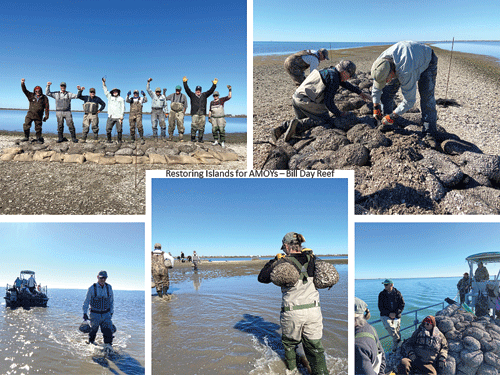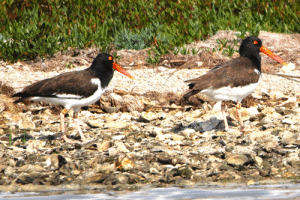
The Saturday after Christmas a dozen volunteers loaded a few hundred sacks of oyster shell onto a barge destined for Bill Day Reef. The sacks of shell were a result of multiple days of volunteer effort filling sacks in Seadrift and transporting them to POC TPWD dock. The project was organized by San Antonio Bay Partnership (SABP) and funded by a CMP (coastal management plan) grant from the Texas GLO. Volunteers from the Texas Master Naturalist Mid-Coast Chapter and Braskem (Seadrift) spent 5 days in 2023 shoveling shell into the mesh bags from an old pile of hardened dirt and shell.
The extreme low tide made a messy, effortful job of the offloading. Each sack, ranging in weight from 20 to 40 lbs, was carried over 100 feet through shallow water and slippery mud to its destination at the high point of the small shell island.
So why spend all this time and effort to put shell onto Bill Day Reef? According to Allan Berger, SABP chairman, “To elevate the island so that American Oystercatcher might nest there again.” “Brigid and I have been monitoring nesting oystercatchers for several years.” Berger explained. “In years past, we had a couple pair of oystercatchers nesting along Bill Day Reef but the smaller islands have washed away.”
According to the American Oystercatcher Working Group, the oystercatcher (banding code AMOY) is one of the few birds to specialize on bivalve mollusks living in saltwater and is completely restricted to marine habitats. Its future success depends on its coexistence with humans and the mitigation of factors affecting rise in sea level.
“So why not try to elevate the reef?” Berger said, “All we needed was shell and lots of help. Even if the oystercatchers don’t nest, the shell is back where it belongs.”
Last year we monitored seven oystercatcher nests from Matagorda Peninsula to Panther Lake. They lay three eggs per nest hoping at least one chick fledges (flies). Unfortunately, only one chick of all those nests made it to fledging. Reasons for low survival include wash over and predators. With sea level rising, erosion of shell islands, and high tides of spring storms, eggs and small chicks get washed away. Predators like crabs, coons and coyotes take their share. And, when adult AMOYs are flushed from the nest, gulls and caracara can swoop in and snatch up a chick as quick as a French fry from a McDonald’s parking lot! Nesting season starts in February. So, fishermen, be on the lookout for the black, brown & white bird with the long candy-corn-colored bill, and please avoid shell islands until August. For more information about the American Oystercatcher https://amoywg.org/american-oystercatcher/ To help with island restoration projects email SanAntonioBayPartnership@gmail.com To support local conservation efforts make a donation https://www.sabaypartnership.org/support-us/
-Brigid Berger, Texas Master Naturalist Mid-Coast

Oyster Catchers
